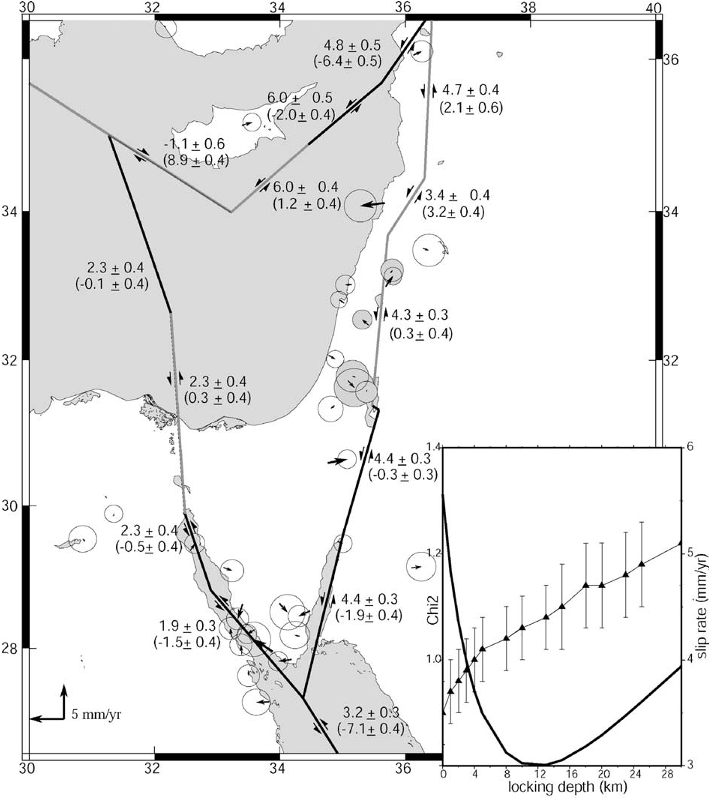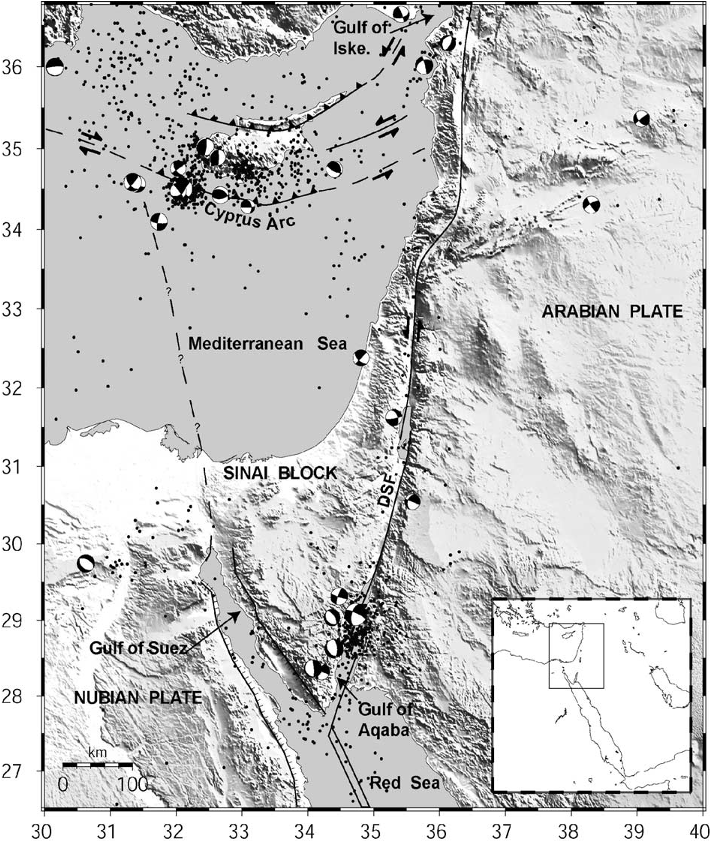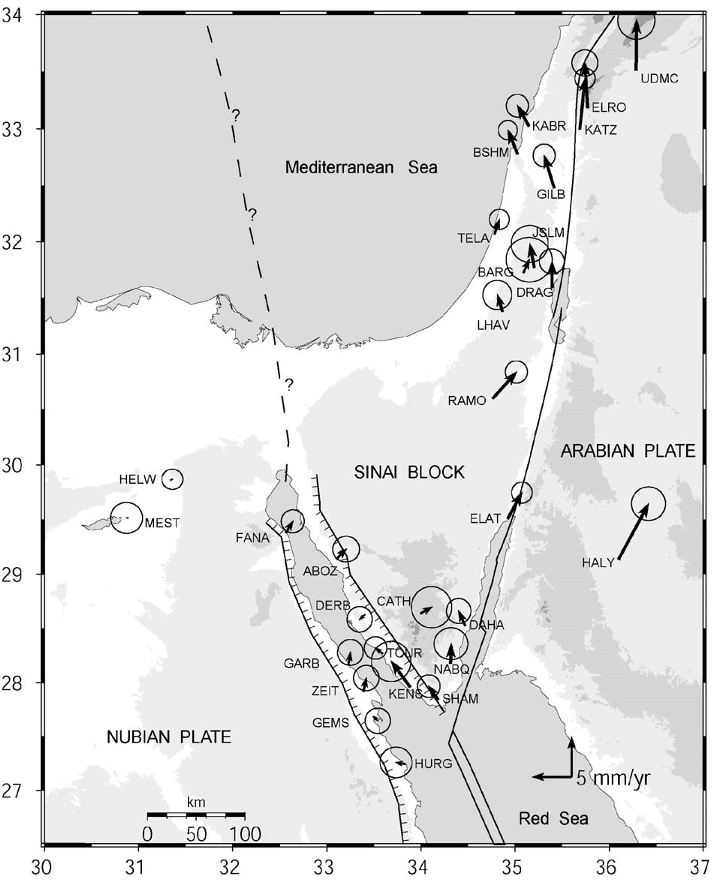GPS evidence for northward motion of the Sinai Block: Implications for E. Mediterranean tectonics
Reads0
Chats0
TLDR
In this article, an elastic block model constrained by the GPS results that is consistent with the regional tectonics and allows us to estimate slip rates for Sinai bounding faults, including the Gulf of Aqaba-southern Dead Sea fault system, is presented.About:
This article is published in Earth and Planetary Science Letters.The article was published on 2005-09-30 and is currently open access. It has received 119 citations till now. The article focuses on the topics: Strike-slip tectonics.read more
Figures

Fig. 3. Elastic block model for the Sinai area showing GPS residual velocities (given in Table 1) for the model described in the text. Faults are vertical and assigned locking depths of 15 km except for the Gulf of Aqaba/Dead Sea fault system that has a locking depth of 13 km, and the western Cyprus Arc that has a 308 dip down to the NE. Residuals are well within the uncertainties for the velocity determinations. Numbers show fault strike slip and fault-normal slip rates and 1-sigma formal uncertainties (fault normal component in brackets; negative for left lateral and extension). Slip rates are averages along each segment. Light modeled faults indicate segments with fault-normal shortening, and dark extension. Inset shows a plot of the local Chi*2 computed from sites close to the fault (shaded error ellipses indicate sites used to estimate fault locking depth) and estimated fault strike slip rate as a function of the locking depth for the Dead Sea fault. The best fit is for a 13 km locking depth and a strike slip rate of 4.3 mm/yr. 
Fig. 1. Topographic (SRTM30) and tectonic map of the Sinai and surrounding region. Dots show seismicity (NEIC), focal mechanisms are from Harvard CMT. Inset shows location of study area within the context of the eastern Mediterranean. DSF=Dead Sea fault, Gulf of Iske.=Gulf of Iskenderum. 
Table 2 Euler vectors relative to Eurasia and 1-sigma uncertainties estimated from this study 
Fig. 2. Simplified tectonic map of the Sinai and surrounding regions show Lines with tick-marks are normal faults, ticks on downthrown block, doubl are given in Table 1. 
Table 1 GPS velocities in an Africa (Nubia)-fixed reference frame and 1-sigma uncertainties for sites shown in Fig. 2
Citations
More filters
Journal ArticleDOI
A Statistical Method for Estimating Catalog Completeness Applicable to Long-Term Nonstationary Seismicity Data
TL;DR: In this paper, a statistical approach based on a deviation criterion was developed to estimate the completeness of earthquake historical catalogs, which is applicable to stationary, non-stationary, and even multimodal nonstationary seismicity rates.
Book ChapterDOI
Geodetic Constraints on the Geodynamic Evolution of the Red Sea
TL;DR: In this article, the authors use geodetic, plate tectonic, and geologic observations to quantitatively reconstruct the geologic evolution of the Red Sea and Gulf of Aden since separation of Arabia from Africa in the Late Oligocene.
Journal ArticleDOI
Seismic structure beneath the Gulf of Aqaba and adjacent areas based on the tomographic inversion of regional earthquake data
TL;DR: In this paper, the authors presented the first 3D model of seismic P and S velocities in the crust and uppermost mantle beneath the Gulf of Aqaba and surrounding areas based on the results of passive travel time tomography.
Journal ArticleDOI
Crustal and uppermost mantle structure beneath the continental rifting area of the Gulf of Suez from earthquake tomography
TL;DR: In this paper, the authors presented a new model of P and S wave velocities in the crust and uppermost mantle beneath the Gulf of Suez and surrounding areas, including the northern portion of the Red Sea.
Journal ArticleDOI
Present-day kinematics in the Eastern Mediterranean and Caucasus from dense GPS observations
TL;DR: In this paper, the elastic block model is used to constrain present-day plate motions and crustal deformation, and the relative Euler vectors between the Nubian, Arabian, Caucasus, Anatolian and Central Iranian plates are estimated.
References
More filters
Journal ArticleDOI
Global Positioning System constraints on plate kinematics and dynamics in the eastern Mediterranean and Caucasus
Simon McClusky,S. Balassanian,Aykut Barka,Coskun Demir,Semih Ergintav,Ivan Georgiev,O. Gurkan,Michael W. Hamburger,K. Hurst,Hans-Gert Kahle,Kim A. Kastens,G. Kekelidze,Robert W. King,V. Kotzev,Onur Lenk,Salah Mahmoud,A. Mishin,M. Nadariya,A. Ouzounis,Demitris Paradissis,Yannick Peter,M. Prilepin,Robert Reilinger,I. Sanli,H. Seeger,A. Tealeb,M. N. Toksoz,G. Veis +27 more
TL;DR: In this article, the authors present and interpret GPS measurements of crustal motions for the period 1988-1997 at 189 sites extending east-west from the Caucasus mountains to the Adriatic Sea and north-south from the southern edge of the Eurasian plate to the northern edge of Africa.
Journal ArticleDOI
Geological evolution of the tethys belt from the atlantic to the pamirs since the LIAS
J. Dercourt,L.P. Zonenshain,L. E. Ricou,V. G. Kazmin,X. Le Pichon,A. L. Knipper,C. Grandjacquet,I.M. Sbortshikov,J. Geyssant,Claude Lepvrier,D.H. Pechersky,J. Boulin,Jean-Claude Sibuet,L. A. Savostin,O. Sorokhtin,M. Westphal,Mikhail L. Bazhenov,J. P. Lauer,B. Biju-Duval +18 more
TL;DR: In this article, the evolution of the Tethys belt from the Pliensbachian (190 Ma) to the Tortonian (10 Ma) is depicted at 1 20,000,000 scale.
Journal ArticleDOI
GPS constraints on Africa (Nubia) and Arabia plate motions
TL;DR: In this article, the authors used continuously recording GPS and survey-mode GPS (SGPS) observations to determine Euler vectors for relative motion of the African (Nubian), Arabian and Eurasian plates.
Journal ArticleDOI
Plate tectonics of the Mediterranean region.
TL;DR: The seismicity and fault plane solutions in the Mediterranean area show that two small rapidly moving plates exist in the Eastern Mediterranean, and such plates may be a common feature of contracting ocean basins.
Journal ArticleDOI
Estimating regional deformation from a combination of space and terrestrial geodetic data
TL;DR: In this article, an approach for efficiently combining different types of geodetic data to estimate time-dependent motions of stations in a region of active deformation is discussed. But the work is limited to the case of finite constraints and stochastic perturbation of parameters.
Related Papers (5)
GPS constraints on continental deformation in the Africa-Arabia-Eurasia continental collision zone and implications for the dynamics of plate interactions
Robert Reilinger,Simon McClusky,Philippe Vernant,Shawn Lawrence,Shawn Lawrence,Semih Ergintav,R. Cakmak,Haluk Ozener,Fakhraddin Kadirov,Ibrahim Guliev,Ruben Stepanyan,Merab Nadariya,Galaktion Hahubia,Salah Mahmoud,K. Sakr,Abdullah ArRajehi,Demitris Paradissis,A. Al-Aydrus,Mikhail Prilepin,Tamara Guseva,Emre Evren,Emre Evren,Andriy Dmitrotsa,S. V. Filikov,Francisco Gomez,R. Al-Ghazzi,Gebran N. Karam +26 more